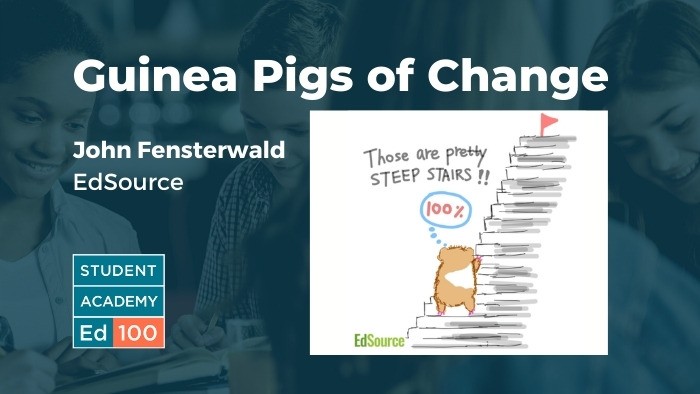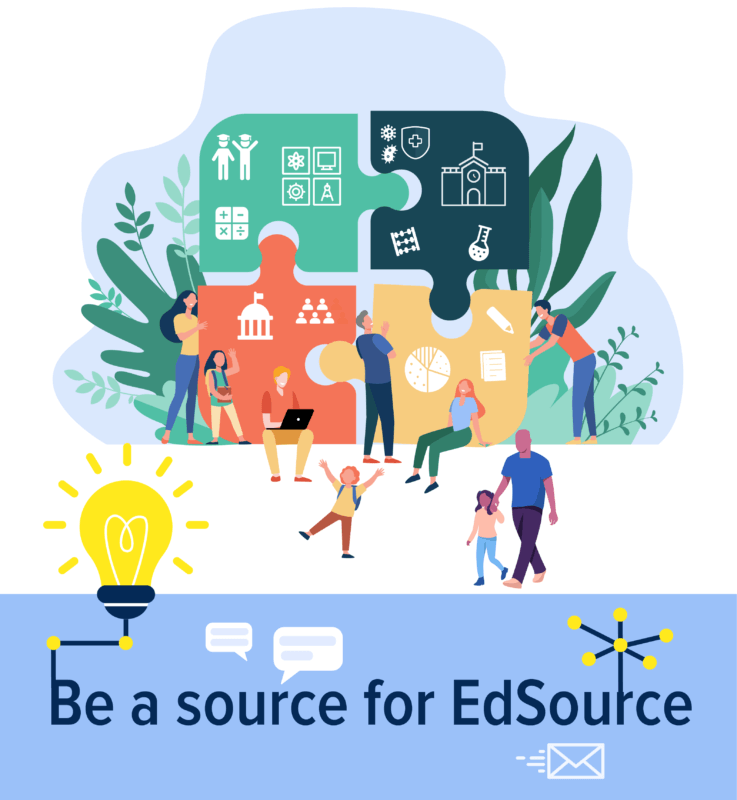Students as Guinea Pigs

The education system has changed. Students have lived it.
A K-12 education lasts 13 years. As students grow up, they change… and, less perceptibly, the education system changes, too. At the Ed100 Academy for Student Leaders this summer, we asked EdSource’s John Fensterwald to provide today’s high school students a sense of their own history: How has the California education system changed during their lifetime?
Fensterwald responded to this request with a creative twist. Addressed to the class of 2020-21, “The Ginny Chronicles” is a short video that reviews two decades of events and federal and state education policies. The class of 2021 experienced their education in the context of a lot of change — two recessions, a pandemic and policies like the No Child Left Behind Act (NCLB). As Fensterwald colorfully explains, these students have been guinea pigs of change.
Recession
The education system tends to change slowly, and moments of significant change tend to require a crisis. Generation Z was born into such a crisis. A sharp stock market downturn and recession undermined education funding. California’s state leaders had a clear vision for a more fair and rational funding system, and they managed to get it passed into law. The new system was called the Local Control Funding Formula (LCFF).
The class of 2021 lived through the transition to local control funding. In their early grades they also felt the pinch of the recession, especially in the form of big class sizes and slim support for teachers. In 2010, California funding per student was the worst in the nation in terms of purchasing power per student.

Federal influence vs. state control
For the class of 2021, annual testing was a normal part of their school experience, as required by the federal No Child Left Behind act. Until the end of the Obama administration, there were reasons for school leaders and educators to feel tense at testing time. The policies were “well intentioned,” Fensterwald said, but “ultimately destructive.”
Common Core Standards
Perhaps the most sweeping changes that affected Generation Z in the classroom involved the adoption of the Common Core State Standards. The transition to Common Core is now complete, but years were lost, Fensterwald said, in the confusing period between when the standards were adopted and when there were decent materials available to teach with them. “Ginny remembers 2010 as a good year to go to the movies,” Fensterwald quipped.
The Dashboard
During the education of the class of 2021, the state of California wrestled with how to define success at a systemic level. Schools and teachers need to be allowed room to make school inspiring and motivating. A hyperfocus on math and English results had led some schools to make education dull. California introduced the School Dashboard as a more flexible tool to measure success and notice gaps. Fensterwald suggested that all guinea pigs (all students) should have certain rights:
|
Ginny’s Bill of Rights for 2021-22 |
|---|
|
We’re entitled to computers and Internet connections |
|
We’re entitled to full-day instruction (or online learning for those who want and need it) |
|
We’re entitled to in-school tutoring to help us catch up on what we missed |
|
We’re entitled to after-school programs |
|
We’re entitled to more counselors in our schools |
|
We’re entitled to qualified, caring, well-trained teachers (and I’m entitled to a career pathway to help me become a veterinarian) |
|
We’re entitled to know how $52 billion in Covid aid will be spent to help students |
|
All guineas deserve a quality, well-funded education. |
COVID-19 prompted historic increases in education funding
Policies passed by voters under the Brown administration, coupled with stock market growth and Federal assistance have delivered a dramatically better budget for California’s schools. In an interview with Fensterwald a few weeks after the conference, California State Board of Education chair Linda Darling-Hammond predicted that, for the first time in decades, California’s per-pupil spending will likely exceed the national average. Based on the LCFF funding formula, a significant slice of that money will go to districts with the highest needs. The Ginny generation learned through California's lean years. Perhaps the years ahead will be better.
Be a Source for EdSource
Fensterwald concluded by thanking students for participating in the Ed100 Student Academy. He also extended an invitation. EdSource needs the voices and perspective of students in its reporting, and it depends on contributors to provide it. Students can “be a source for EdSource” by signing up here: Be a Source for EdSource
Tags on this post
Change Funding HistoryAll Tags
A-G requirements Absences Accountability Accreditation Achievement gap Administrators After school Algebra API Arts Assessment At-risk students Attendance Beacon links Bilingual education Bonds Brain Brown Act Budgets Bullying Burbank Business Career Carol Dweck Categorical funds Catholic schools Certification CHAMP Change Character Education Chart Charter schools Civics Class size CMOs Collective bargaining College Common core Community schools Contest Continuous Improvement Cost of education Counselors Creativity Crossword CSBA CTA Dashboard Data Dialogue District boundaries Districts Diversity Drawing DREAM Act Dyslexia EACH Early childhood Economic growth EdPrezi EdSource EdTech Education foundations Effort Election English learners Equity ESSA Ethnic studies Ethnic studies Evaluation rubric Expanded Learning Facilities Fake News Federal Federal policy Funding Gifted Graduation rates Grit Health Help Wanted History Home schools Homeless students Homework Hours of opportunity Humanities Independence Day Indignation Infrastructure Initiatives International Jargon Khan Academy Kindergarten LCAP LCFF Leaderboard Leadership Learning Litigation Lobbyists Local control Local funding Local governance Lottery Magnet schools Map Math Media Mental Health Mindfulness Mindset Myth Myths NAEP National comparisons NCLB Nutrition Pandemic Parcel taxes Parent Engagement Parent Leader Guide Parents peanut butter Pedagogy Pensions personalized Philanthropy PISA Planning Policy Politics population Poverty Preschool Prezi Private schools Prize Project-based learning Prop 13 Prop 98 Property taxes PTA Purpose of education puzzle Quality Race Rating Schools Reading Recruiting teachers Reform Religious education Religious schools Research Retaining teachers Rigor School board School choice School Climate School Closures Science Serrano vs Priest Sex Ed Site Map Sleep Social-emotional learning Song Special ed Spending SPSA Standards Strike STRS Student motivation Student voice Success Suicide Summer Superintendent Suspensions Talent Teacher pay Teacher shortage Teachers Technology Technology in education Template Test scores Tests Time in school Time on task Trump Undocumented Unions Universal education Vaccination Values Vaping Video Volunteering Volunteers Vote Vouchers Winners Year in ReviewSharing is caring!
Password Reset
Search all lesson and blog content here.
Login with Email
We will send your Login Link to your email
address. Click on the link and you will be
logged into Ed100. No more passwords to
remember!















Questions & Comments
To comment or reply, please sign in .